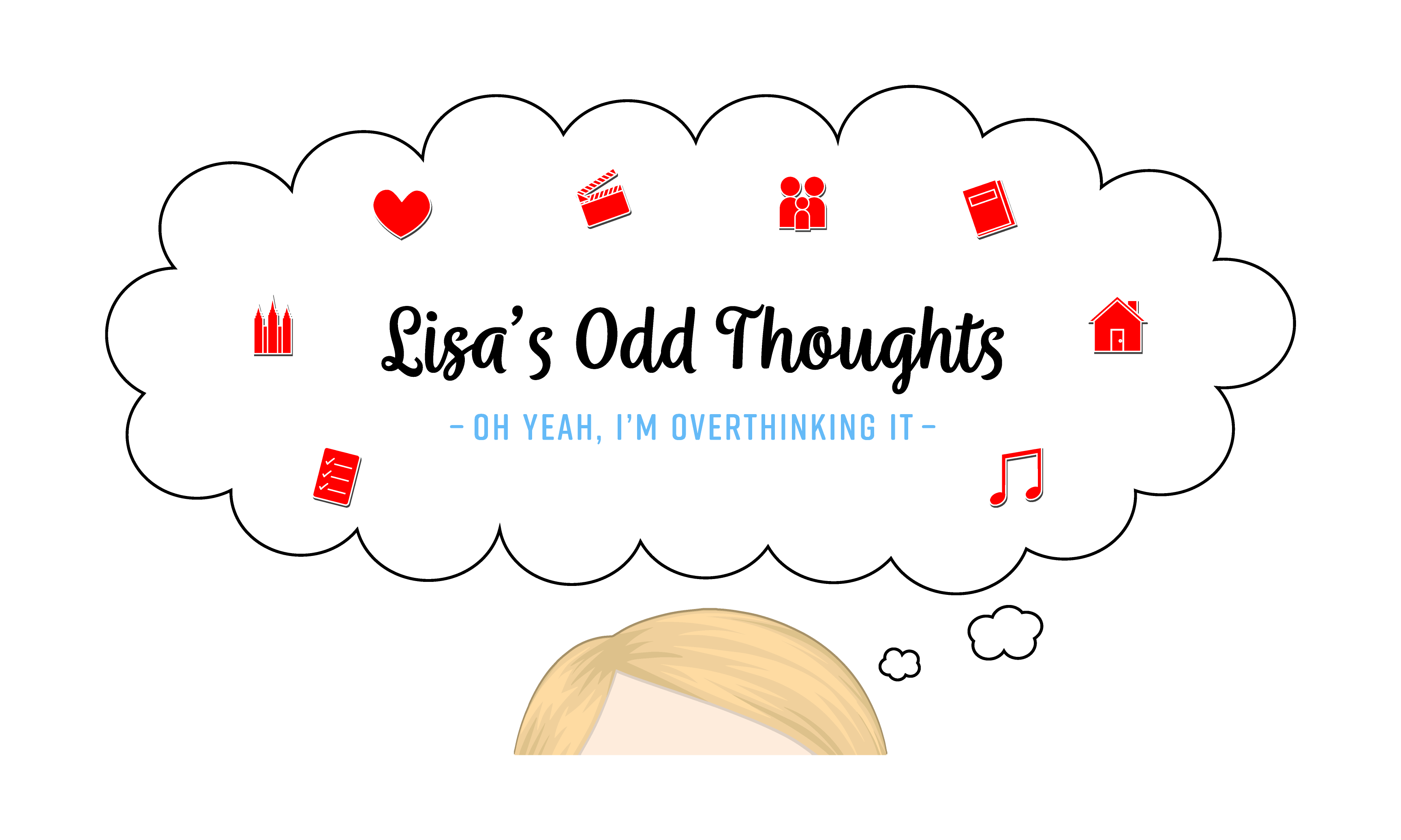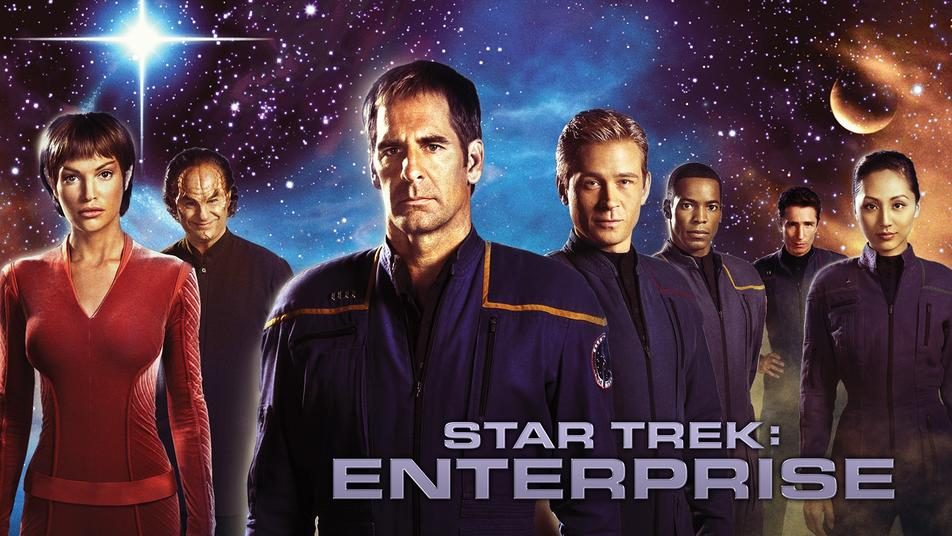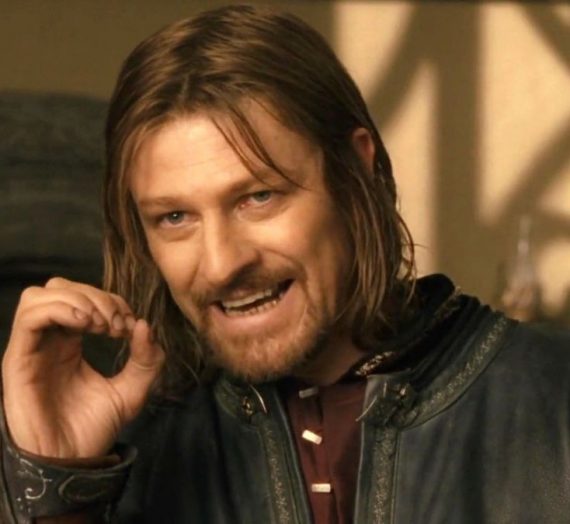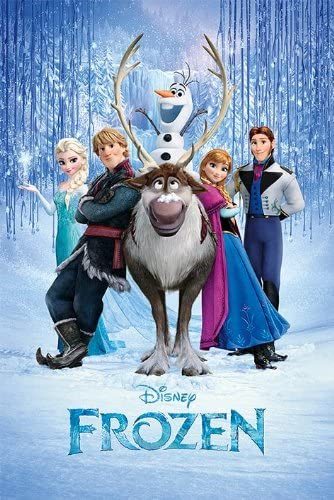Let’s take a stroll down memory lane and return to the early 2000s. I was in middle school when I discovered a new favorite TV show: Star Trek Enterprise.
My parents were both Star Trek fans throughout my childhood and I remember watching a few bits and pieces of The Next Generation or Voyager with them here or there, but it was Enterprise that got me really hooked; that was finally my show. I still remember new episodes aired on Friday nights and then they’d play that same new episode again on Sunday evening and I’d make a point to watch it both times just because I enjoyed it that much.
I jumped into the show early in the third season, which Enterprise fans know features the season-long conflict with the Xindi, an alien race bent on destroying Earth with only the courageous Captain Archer and his nearly-defeated-multiple-times crew to stop them. It’s super exciting, edge-of-your-seat kind of stuff and I couldn’t get enough.
After the show ended, it was the very first TV show my mom bought on DVD, back when that was a brand new concept and something I’d never even imagined could be a thing. I could buy the entire show, like a movie, and put it on my bookcase? That I could sit down and watch any time I wanted? I didn’t have to wait until Friday night anymore? And they also came in these spacey, decorative boxes? I couldn’t think of anything cooler.

And so I watched the entire show, start to finish, on my fancy DVDs in their spacey, decorative boxes. Several times. Looking back, those boxes are the biggest freaking pain in the butt to use, but they looked cool and owning an entire show was still such a novelty at the time that I didn’t even care. But now I’ve been spoiled by that easy Netflix button which is just so much nicer than fighting those darn boxes!
My interest in Enterprise launched me into the rest of the Star Trek franchise. My parents also eventually bought the painfully-unwatchable Original Series and The Next Generation on DVD, both of which also included needlessly-difficult boxes, by the way; why was that a thing? Eventually I borrowed Deep Space Nine and Voyager from my local library (this is all pre-Netflix and online streaming, folks; this is my equivalent of “Back in my day I used to walk uphill in the snow both ways!”).
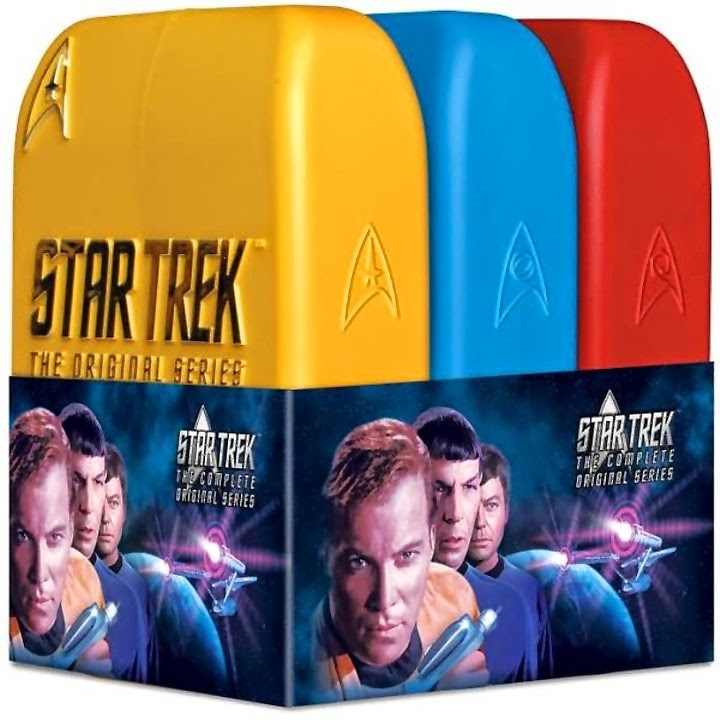
And I fell in love with the Star Trek universe (except for that awful Original Series. Seriously, how that 1960’s Captain Kirk launched one of the biggest sci-fi franchises of all time is honestly beyond me). But as much as I enjoyed those other shows, none of them really stuck with me in the same way and Enterprise always remained my favorite.
But as I watched and compared the various shows I came to realize a few sad truths about my favorite Star Trek installment. Enterprise got the short end of the stick and I, as one of its biggest fans, got totally shafted. Next Generation, DS9, and Voyager all enjoyed pleasantly long seven-season runs. Most of them were only just catching their stride in their fourth seasons and putting out their best content and most-loved episodes. So why did Enterprise get cut short? Why is Enterprise’s fourth season so…so fine after such an exciting third season? Why did Enterprise have to end on that unspeakably bad finale that was nothing short of stupid?
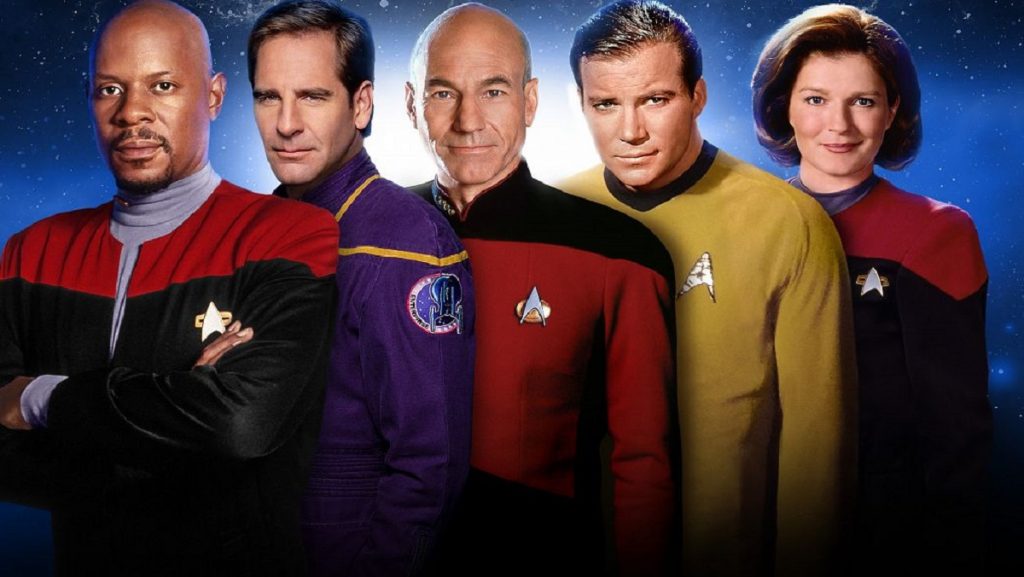
Why, Enterprise, why? What did those other shows have that Enterprise didn’t? What happened to Enterprise?
Well, let’s talk about it.
Firstly, I have to acknowledge that poor Enterprise was fighting an uphill battle from the get-go for several reasons.
Star Trek fatigue. Star Trek had been on air nonstop since the start of The Next Generation in 1987, and so some critics have pointed out that Enterprise, which first aired in 2001, was facing a “Star Trek fatigue” from the beginning. There’s only so much Star Trek that typical TV-watchers can handle, after all, and interest in the latest Voyager had already been dwindling at the start of Enterprise. There just wasn’t as much desire for more Star Trek content. That didn’t affect me personally at the time, with Enterprise being my first real look into Star Trek, but when answering the question, “Why did Enterprise get cancelled so soon?” this is a valid point to be addressed.
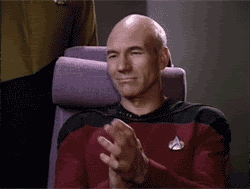
The Next Generation, DS9, and Voyager were TV giants. On a similar note to the fatigue issue, the three previous Star Trek shows were hugely successful and had big fan bases. Those are big Star-Trek-sized shoes to fill. No pressure, my little Enterprise, but it had a lot to live up to.
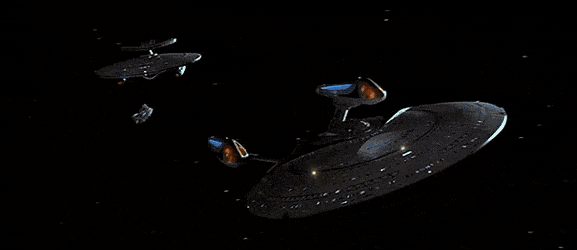
It’s a prequel. Enterprise takes place roughly two hundred years before those other series, and prequels can be notoriously difficult to pull off. Inevitably they just become nostalgic name-drops with very little significant content. Enterprise absolutely suffered from this phenomenon, especially in the infamous season four, and sometimes had entire episodes (not usually very good ones) whose entire purpose was to wink at other series.
For example, season four’s episodes 18 and 19, “In a Mirror Darkly I & II” took place solely in the dark mirror universe commonly visited in the Original Series and DS9. But these episodes weren’t very fulfilling to watch as they didn’t include any of the real characters visiting that alternate universe, but was entirely about their evil counterparts whom we don’t actually know or care about.
The entire two-parter was a love song to the Original Series and had no purpose whatsoever except to give a big nostalgic-prequel-wink at the audience: “Get it? Get it? Get it?”
Yeah, I got it. And I didn’t really like it.
On the plus side, Enterprise was actually a very good prequel during its first two seasons (keep reading to see how), but unfortunately all that fizzled out by season four.
The prequel technology isn’t as cool. On a related note, being a prequel also meant that Enterprise’s super-awesome-future technology was actually two hundred years behind the super-awesome-future technology fans were used to in Voyager, making it a little less super-awesome-future-ish. It can definitely feel underwhelming to jump backwards all the way to Enterprise’s modest Warp 5, limited transporter, itty bitty baby weapons, and cramped ship quarters. If you really want some kicks and giggles, watch Enterprise back-to-back with The Next Generation and you’ll agree that the Enterprise D should actually be called “The Luxurious Cruise Ship of the Federation” with its concert hall, massive suites, and nicey nicey bar run by the insightful Whoopie Goldberg.
Yes, that comparatively-primitive look was indeed the intended feel that Enterprise was going for. The pre-Federation Enterprise was not a massive, luxury starship on purpose, and its simplistic and small nature was designed that way to contrast with later starships. But that being said, I understand it’s a complaint that some Star Trek fans have about Enterprise.
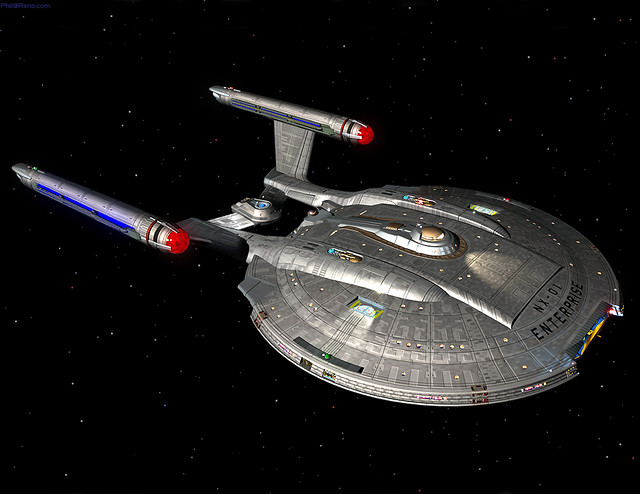
Enterprise never had a Learning-Humanity character. Next Generation had Data, DS9 had Odo, and Voyager had Seven of Nine. These characters are most often fan favorites, and not by random chance. All three of these characters were, in some way or another, learning how to be human: the android impersonating a human, the lonely shapeshifter trying to fit in with humans, and the rescued Borg drone reclaiming her humanity. These characters most often provide both great humor and the most meaningful, touching insights into humanity. That’s why they’re fan favorites, as they deserve to be.

Enterprise, unfortunately, doesn’t have that character. It doesn’t mean that the show can’t succeed without one, it’s just that Enterprise has to look elsewhere for its most meaningful moments that resonate with fans. And following such big fan favorites like Data and Seven, poor Enterprise really struggled without that humanity-seeking crew member.
Enterprise doesn’t have a Holodeck. This one might strike you as funny and it kind of goes along with the previously-mentioned lesser technology, but it’s significant enough to mention independently. Next Generation, DS9, and Voyager all feature episodes revolving around their holodeck (or holosuite in DS9). Many of these episodes capitalize on the same basic formula: the holodeck breaks in some way, trapping the characters inside so they have to play through this fictional recreation before they can escape. Oh yeah, and the safety features always break too. Of course. Not all holodeck episodes are like this, but a good number indeed are.
I found a Reddit list of Star Trek episodes featuring the holodeck in any way and it listed 21 Next Generation episodes, 6 DS9 episodes, and 24 Voyager episodes. Especially in Next Generation and Voyager, that’s nearly an entire season-worth of episodes devoted to the holodeck.
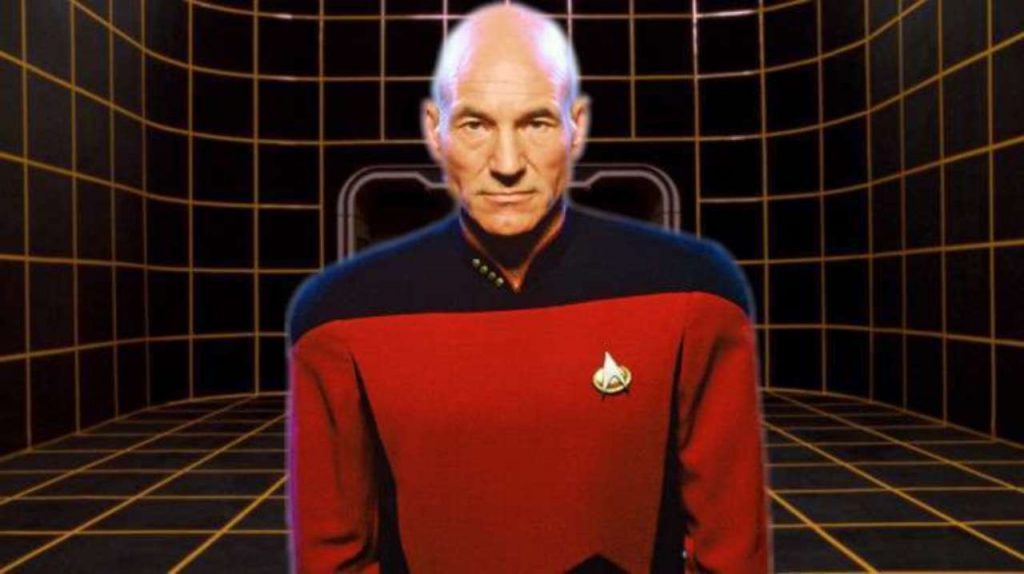
In fact, I enjoy my own personal joke that the Star Trek writers would just tour the other Paramount studios for whatever other sets they already had set up and then write a holodeck episode based on that; waste not, want not. Old western street? Holodeck episode. Medieval great hall? Holodeck episode. 1950’s San Francisco? Holodeck episode!
In all seriousness, the other Star Trek shows could fall back on that Holodeck for all sorts of stories that Enterprise never had the chance to. Poor Enterprise.
With all that in mind, Enterprise had a lot to live up to and attempt to surpass, which all led to its poor reception and early cancellation.
But let’s look at what things Enterprise did really well. And luckily that list starts at the very beginning of the show with its pilot episode, “Broken Bow.”
Enterprise’s Pilot Episode: “Broken Bow”
After such a daunting list of reasons for Enterprise to fail, I’m thrilled to say that my favorite little Star Trek underdog certainly came out swinging. “Broken Bow” is a great pilot episode that shares a good balance of introduction and action-packed story.
We first meet Captain Jonathan Archer who is passionate, stern, and he don’t take no crap from nobody! He knows what he wants, isn’t afraid to tell people when they’re wrong, and stands up for what he believes in, all character traits that remain true throughout the show’s run. He also has a strained relationship with the Vulcans, which is refreshingly new compared to the previous future-utopia we are constantly shown in the Federation. But Enterprise is set before the United Federation of Planets, so it’s interesting to see some conflict between the species that will be such close allies in the future.
We’re also introduced to the rest of the cast, namely the bridge crew.

T’Pol is the Science Officer and the second in command and, being Vulcan, we immediately see her clash with the captain, his obvious foil. But she proves herself useful and intelligent, a great asset to the crew. Despite that, she still has a tense relationship with Archer and an obvious disdain for humans. The pilot episode is a great start and foundation to her future character arc, ending in her admirable loyalty and devotion to both Archer and Enterprise. She’s a great character and she’s great in the pilot episode.
We also meet Dr. Phlox who introduces an interesting new Denobulan alien race to the franchise and is super hilarious. He’s also great and, like Archer, remains true to that pilot character throughout the show. And he’s my personal favorite, just in case you were wondering.
And there’s the southern-twanging engineer Commander “Trip” Tucker, the disciplined British Malcolm Reed working the weapons, Travis Mayweather who was raised on space-faring cargo ships, and another personal favorite in Hoshi Sato the communications specialist and linguistic genius who is afraid of space travel, a unique first for Star Trek characters.
Yes, we begin with a diverse and interesting cast with so much potential. How can you not be excited for the rest of the show and for future episodes?
Besides the great cast, the pilot episode features the humans’ first contact with Klingons (a franchise favorite) and another new species called the Suliban. We also catch a hint at the briefly-mentioned Temporal Cold War, which plays a significant role throughout the rest of the show. The story features a kidnapping, gun fights, undercover sneaking, and high tension throughout. Yes, that pilot episode has everything you could ever want and it’s all great.
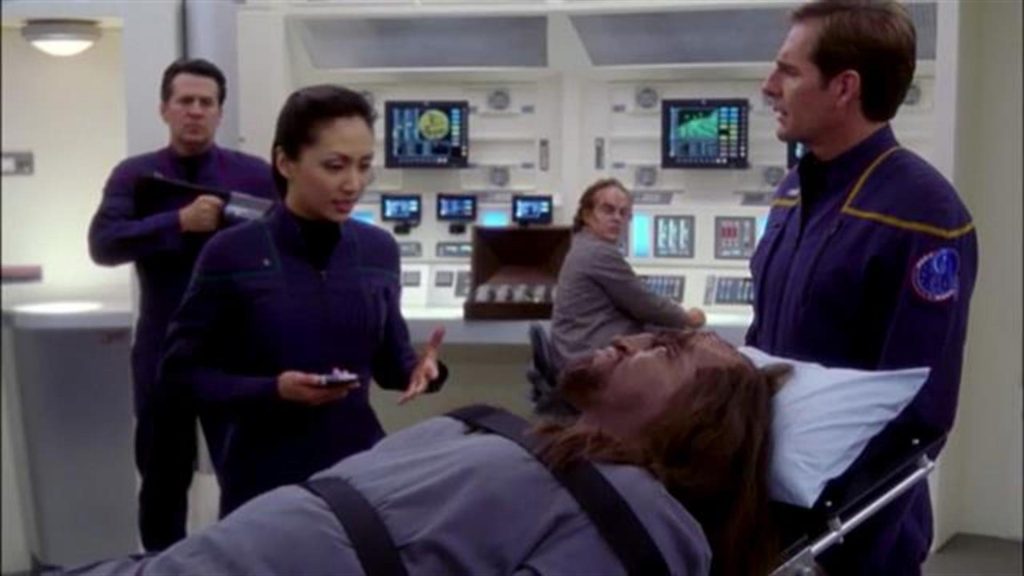
So what next?
Before we move on, let’s all acknowledge together that some of Star Trek sucks, like monumentally is just bad and stupid. But I like to look at Star Trek as a whole: you can’t have the good without the bad, and Star Trek wouldn’t be Star Trek if it also didn’t have some episodes that are cheesey, campy, or just downright stupid. I’m looking at you, hyper-evolved-human-salamaders!
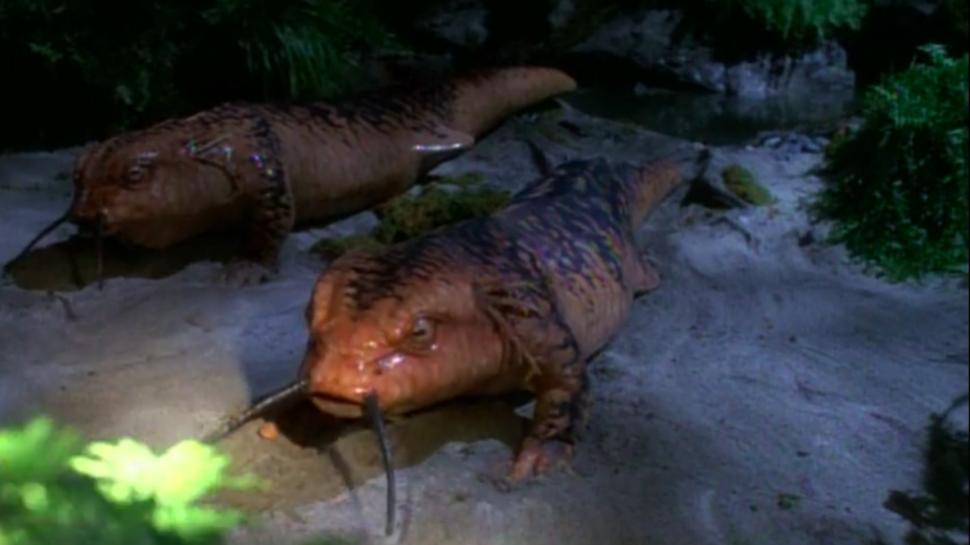
Enterprise, like its predecessors, is no exception: some episodes are just bad.
But some are great.
Star Trek Enterprise: Seasons 1 and 2
The first two seasons were mainly based on one-episode stories and featured making first contact with aliens (both familiar and unfamiliar to the Star Trek universe), exploring new planets, handling the dangers of space travel, and having those sorts of Star-Treky adventures. Some are action-packed like the pilot, some are poignant, and some are just plain fun and entertaining. There are a good handful of episodes that sort of fall by the wayside as being only mildly interesting, but there are plenty of gems and lots of good things happening throughout the show as a whole.
Great Things About Enterprise’s First Two Seasons:
- The show stays faithful to the true spirit of Star Trek.
Captain Archer and his crew grapple with moral issues just as often as outer-spacey ones. While exploring the galaxy, the crew upholds its values of peace, freedom, and sanctity of life. The best part of Star Trek has always been its discussion of morality and right versus wrong, and Enterprise honors that in many great episodes, some of which are mentioned below. But this isn’t a comprehensive list of those episodes; there are plenty more and Enterprise handles them very well.
- A few longer, show-spanning storylines are put in place in interesting and intriguing ways. These are not two-part only episodes, but reoccurring stories that are revisited from time to time. They are reminders that the crews’ actions have long-lasting consequences and that the galaxy is changing around them.
For example, the Temporal Cold War is a reoccurring conflict, including the introduction of a secret temporal agent posing as one of Enterprise’s crewmen. The Temporal Cold War, accompanied by squabbles with the Suliban, always makes for action-packed and exciting episodes. It forms an intriguing and cohesive story arc without dominating the show.
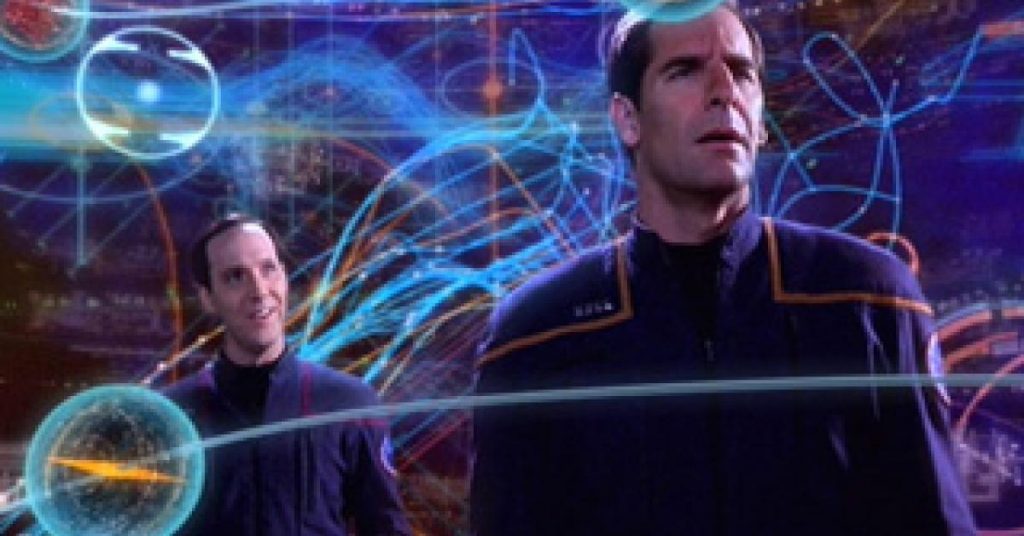
Another good storyline the show explores is one I like to refer to as the “pre-Federation” story. This is where Enterprise plays the role of prequel extremely well. The United Federation of Planets is the utopian society in which all the other Star Trek shows exist. But Enterprise happens before the Federation has even begun, which means there is a lot of opportunity to set up how that Federation came into being and Enterprise handles this extremely well during its first few seasons.
The episode “The Andorian Incident” introduces an on-going conflict between the Vulcans and Andorians that is revisited multiple times throughout the show. It makes for a great prequel-content because we know these species will eventually unite and find peace together, but it’s a great story about how that peace and alliance began. And it’s an all-around good episode regardless.
Speaking of Vulcans, Enterprise handles a lot of Vulcan-based episodes, having a Vulcan Science Officer as second in command. T’Pol has an ongoing story that includes different aspects of Vulcan culture.
In the episode “Fusion” we learn that there are different factions of Vulcans who follow different teachings of Surak (who is, for all intents and purposes, the equivalent of Vulcan-Jesus). Vulcan culture is divided and has some significant differences from the future Vulcan we see in other Star Trek shows. Most notably in this particular episode, we learn that the traditional Vulcan mind-meld is, at this time in history, a taboo and dangerous act, but T’Pol is forced into one against her will by a Vulcan extremist (it’s an allegory for sexual assault, which also makes it a really great episode). This storyline continues as she suffers a neurological disorder from the assault that she deals with throughout the show. This, as well as the unstable Vulcan culture, serve as a very interesting prequel to the later Vulcans we know and love, and a really good ongoing story arc.

- Speaking of being a great prequel, Enterprise discusses the Prime Directive in very poignant and meaningful ways.
Not only is Enterprise a great prequel with those “pre-Federation” storylines, but it is also a great prequel in discussing the Prime Directive, or the lack of it. The future Federation’s highest law is the Prime Directive which states that they, as explorers, mustn’t interfere with other cultures. It’s a big deal for the other shows and all the other captains, at one point or another, grapple with the morality of abiding by or breaking this highest law.
Enterprise, however, exists before the Prime Directive, but Captain Archer likewise faces it on a few occasions. I really enjoyed the episode “Dear Doctor” both because it focuses on Dr. Phlox and because of the moral dilemma he and Archer face. They meet a less-advanced alien race who are dying of a genetic disease and Archer must decide whether or not to interfere and give them warp technology as a means of searching the galaxy for help. Or, they debate simply giving them a cure for this disease. However, Dr. Phlox argues that curing them would be giving the secondary species on the planet an unfair evolutionary disadvantage (he gets the basic concept of evolution entirely wrong here, but that’s not the point). It’s a really good episode with a morally gray ending, which I like.
There are quite a few other episodes that also handle this issue. T’Pol usually serves as Archer’s foil, both for the better and for the worse. She often has to remind him not to get involved with alien issues, like a good Vulcan would, to which the captain must then decide whether or not to take her advice. Sometimes he leaves well enough alone, but sometimes he doesn’t. And in both scenarios, sometimes things turn out well and sometimes they don’t. Nothing is black and white, which makes for good stories.
“Cogenitor” is another good episode that addresses the need for a Prime Directive. They meet a species with a third gender, but these third-gendered people are horribly mistreated by society (it’s a feminist allegory). Commander Tucker can’t stand to see someone so discriminated against and so gets too involved and tries to interfere. Despite his good intentions, his actions ultimately end in a third-gendered person tragically committing suicide. Yep, it couldn’t be a more obvious nod to the future Prime Directive in very well-done prequel fashion, and it still stands as a good episode on its own.
- The first two seasons emphasize a lot of character development, growth, and relationships, again keeping with solid Star Trek style.
Episodes like “Breaking the Ice” see Archer struggling with his own pride in asking Vulcans for help. “Silent Enemy” is a lighthearted and touching story of Hoshi trying to find out Malcolm Reed’s favorite food to surprise him for his birthday. “Shuttle Pod One” shows a nice bonding moment between Tucker and Reed. “A Night in Sickbay” features Archer enduring the antics of the very funny Dr. Phlox while his dog is sick overnight in sickbay—very entertaining.
Most of the characters develop really well-written and poignant character-arcs as well. Hoshi, who is afraid of space travel, faces her various fears multiple times and obviously struggles to find her footing on this frightening and claustrophobic starship. Archer learns to reel in his pride when he makes mistakes and even comes to understand (sometimes) the Vulcans’ difficulties in “holding back” the humans’ warp program until they were “ready,” something he initially begrudges. Space exploration isn’t as glamorous or peaceful as he imagined, and watching him learn that is great character development.
My favorite character arc definitely shows in T’Pol. Remember in the pilot episode she very clearly dislikes humans and her new assignment on Enterprise. She’s Captain Archer’s opposite in nearly every way, and while that means that they disagree and argue often, she gradually develops a great respect for him. She even goes so far as to later defend his actions in the previously-mentioned episode “The Andorian Incident” to her superiors, siding with the humans over the Vulcans.
Further, not only do we see her loyalty to the captain grow, but her devotion to the crew and ship as well. In the second season’s episode “Catwalk” Archer encourages her to mingle with the crew more and get to know them, to which T’Pol admits that she struggles with. But that episode seems to open her up and she joins the crew for movie night, finally beginning to bond with her human crewmates, which continues throughout the rest of the show.
Another brief note about T’Pol: earlier I said that Dr. Phlox and Hoshi are my favorite characters, but T’Pol has definitely got to be on that list too. Even though she’s an emotionless Vulcan, she has this hilarious dry sarcasm in the first two seasons that is just great. I can also appreciate that writing emotionless characters is probably hard (and boring), but T’Pol is very realistic and interesting, with honest struggles, admirable convictions, and a very distinct personality. I really like watching T’Pol and she’s a great asset to the show in general.
Yes, the first two seasons lay a solid foundation of character and relationship growth.
- The limited technology sets up a lot of great episodes and conflict.
This sounds counterintuitive to my earlier point: Enterprise’s simpler and lack-of technology isn’t as cool as the technology and holodecks in the other series. Yes, I still stand by that statement.
But at the same time, sometimes Enterprise uses its lack of technology in really great ways.
Another issue Enterprise had to face was distinguishing itself from the other shows, and its lesser-technology was a great way to do that. The ship itself is smaller, the uniforms are more utilitarian and astronaut-like, and the transporter is new and untrusted technology.
While Captain Picard sails around the galaxy in a cruise ship sipping his fancy tea and listening to an android’s poetry, Captain Archer and his crew are truly roughing it, space-style. It really ups the stakes in a lot of ways and makes the show different than its predecessors in a fun and interesting way.
The episode “Catwalk” is a great example of this: the ship and crew are threatened by a huge storm and have to take refuge in the narrow, cramped catwalk along their warp nacelle, which is the only place on board that can protect them from the storm’s radiation. They stay cramped up there for a week, riding out the storm.
Oh yeah, and they fight aliens and stuff; classic Star Trek style.
It’s a really exciting episode and is very different than anything you’d see on Next Generation.
- The crew’s excitement is wonderfully contagious!
I have to give credit where credit is due: one of the things that makes the early episodes of Enterprise really fun to watch is that the crew itself, the characters, are super excited to be there.
This is the very first warp-5 starship and they are the very first ones to just fly off into space and go exploring, and they love it! They are super psyched every time they find a habitable planet, meet new aliens, or even find a really big comet. Their excitement is fun and contagious, which just makes the show fun to watch, even if the rest of the episode is really campy or cheesey. And that, I think, is a sign of great television writing.
- “Regeneration”
I can’t talk about great things in Enterprise without mentioning this season two episode, another personal favorite. “Regeneration” is a sequel to the Next Generation movie “First Contact” (oh my gosh, so is this episode a sequel or prequel? Neither? Both? Darn it, time travel is so confusing!).
Some of the Borg that Picard fought in the past during “First Contact” were accidentally trapped and frozen on Earth until they are accidentally woken up and set loose to wreak Borg havoc…I mean Borg perfection. And then Archer and company have to fight this new, unknown terror and stop them from sending a message to their Borg collective…and not be assimilated in the process!
I said that “In a Mirror Darkly” was entirely a nostalgic wink to the other Star Treks with no significant content otherwise, something that usually doesn’t go over too well in prequels. One might argue that “Regeneration” is the same thing, being entirely a nostalgic wink to “First Contact.”
I’ll accept that argument, but only if you also acknowledge that while “In a Mirror Darkly” is super boring and meaningless, “Regeneration” is a thrilling nail-biter from start to finish. It’s super fun to watch, super intense, and all around a great episode.
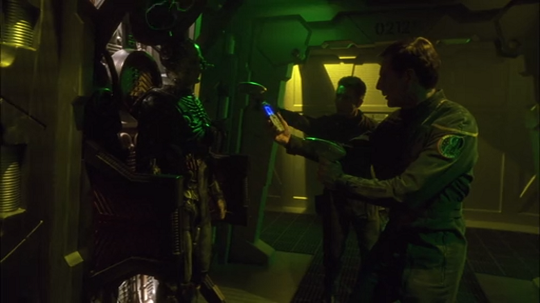
This episode also lends to a couple really fun Star Trek fan theories, which I enjoy. The Borg in the episode are trying to construct a device to send a message to the other Borg across the galaxy, telling them to come over to Earth asap and assimilate them before Picard gets in the way two hundred years later. Even though the Enterprise crew ultimately defeat those Borg, they fail in preventing that message and the invitation is sent. Archer discusses how disappointed he is in their failure with T’Pol and she reassures him that the message won’t even reach its destination for two hundred years.
*wink wink*
The Next Generation, and the next encounter with the Borg, happens approximately two hundred years later. So the fan theory says that the Borg received that message and were already preparing to enter the Alpha Quadrant and go after Earth when Q, on The Next Generation, introduced the Enterprise D to the Borg. Some fans suggest that Q didn’t do this just to play a cruel trick on Picard, but to give him a fair warning: these guys know you exist and they’re coming after you, so you better get your butt ready!
Anyway, it’s all in fun and it’s a great example of how to play up the nostalgia points while still offering a great story.
The Beginning of the End…Of the Other Characters:
Despite the good that happened in the first couple seasons, there is also one little unfortunate nugget I have to mention in order to set up a future issue: the demise of all other characters…except for Captain Archer.
Read on for more details, but I’ll briefly summarize: particularly through seasons three and four, most of the other characters kind of faded away into blank faces that sat on the bridge and pressed the buttons when the captain told them to. I wish I could say that issue was exclusive to the last and worst season of the show, but unfortunately such a sad ending was foretold by a couple bad episodes in those early seasons. Let me point out the worst offender and why it was such a problem, season two’s episode “Dead Stop.”
In the previous episode Enterprise had been badly damaged and now needs some help with repairs. They are directed to this artificially-intelligent repair space station that indeed helps repair their ship, but it all has a too-good-to-be-true sort of feeling; everything is too nice and easy and it gives the audience a spooky sense of foreboding. Then Travis Mayweather is lured into a trap by this sentient station and presumably killed.
It’s all tragic and sad and whatnot, but then…plot twist! They find out that Mayweather isn’t dead at all, but has been kidnapped and his mind hooked up to some brain-control-something-techno-babble-device-thing and is now being forced to power the station with his mind (yeah, that’s classic spacey Star Trek stuff right there). And so they launch a rescue, unhook him from all that stuff, destroy the space station, and go on their merry little way. Yep, it’s your basic one-off little exploring-outer-space kind of story.
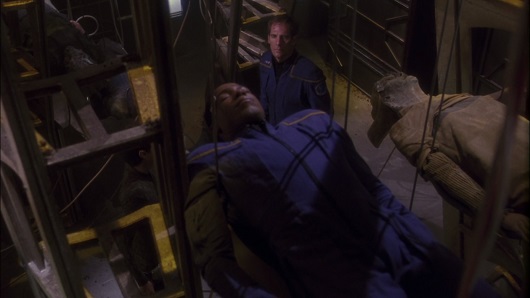
The important scene to mention here is that moment when everyone thinks Travis is dead. His body (a fake, we later learn, planted there by the evil space station) is lying in Sickbay and Hoshi Sato goes to visit. She is all upset that he’s dead and has this little emotional moment with Dr. Phlox mourning for him. She tells this story of him playing a prank on her and convincing her to try to communicate with a “new alien life-form” that just turned out to be a bowl of jell-o. It’s a funny little story and is meant to be a touching moment, if it weren’t so bad.
There is a common phrase in the writing world: “Show, don’t tell.” It means what it sounds like: show what is happening instead of telling it. Instead of, “He was mad,” write, “He balled his hands into fists and gritted his teeth. And then he punched the freaking wall!” The reader knows that character is mad based on what is shown, rather than being spoon-fed lines like, “He was mad.”
This scene of Hoshi mourning Travis’s death is a classic example of Telling, not Showing. Besides that her amusing jell-o story was never actually shown at any time, we’ve rarely seen Hoshi and Travis have any sort of relationship ever. Sure, they’re friendly, but not any more so than with any other character. And we’ve never seen Travis to be a prankster of any kind, not ever. So Hoshi’s little story is super out of character for both herself and for him. So it’s only purpose is to tug at our heartstrings, but it just doesn’t carry the emotional oomph that it should.
Let’s compare to a similar scene in Voyager.
In Voyager ‘s season three episode “Coda,” Captain Janeway gets critically injured and killed in a big storm. Her “ghost” wanders the ship unseen and unheard, wracked with having to accept her own death. She even meets the “ghost” of her deceased father, who urges her to “go into the light.”
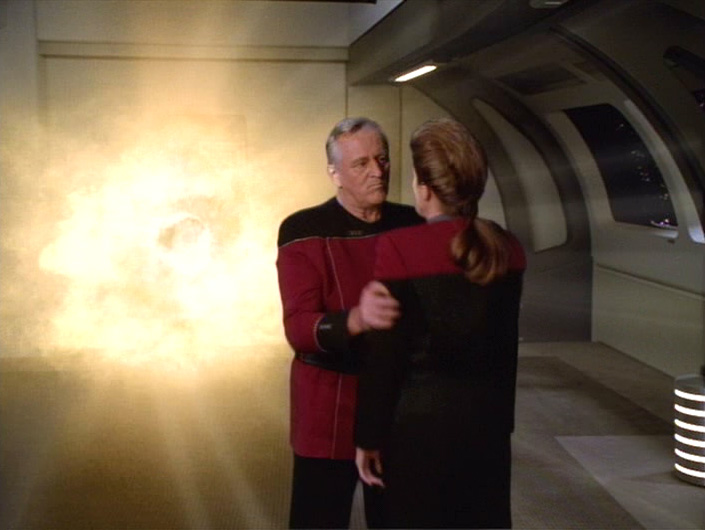
Eventually she watches her own funeral and listens to her crewmates share how meaningful her relationship with them was. It’s a very touching scene, and actually does carry the emotional oomph it intended.
But don’t worry; just like Travis isn’t really dead, Janeway isn’t really dead either and all ends well.
Oh yeah, and she fight aliens and stuff; classic Star Trek style.
So why does this Voyager scene carry so much more emotional weight than the Enterprise one? Because we’ve been shown Janeway’s relationships with her crew over and over and over again, particularly with Chakotay. None of his grieving feels forced because we’ve seen them become best friends for years.
But Travis and Hoshi…not so much.
It’s this sort of thing that especially makes me feel like I got the short end of the stick, as a big Enterprise fan. Do you remember how I said the pilot episode was so good and showed so much potential, particularly with its diverse and interesting cast? I stand by that—the pilot was great and the cast had so much potential.
Sadly, potential alone doesn’t carry a TV show. They just sort of…dropped that potential ball. All those different personalities gradually just drifted away.
But can you imagine if we did see a Hoshi-Travis relationship? If he really was a tease and a goofball, making fun of her and pranking her because she’s so gullible and falls for it every single time? He’d tease her about being afraid of space travel, seeing as he grew up on a cargo ship and all, and they’d have all sorts of fun banter back and forth about it. But he’d also be super protective of her, like a big brother type of role; he gets to tease her, but no one else does and he’ll fight anyone who tries.
What if they were best friends, like Tom and Harry, Geordi and Data, and were seen off-duty playing games, sharing hobbies, and planning their next silly adventures together? And hey, if you want to throw in a romantic relationship between them, you’d be perfectly set up for it.
If all of that had been a thing, a real thing, then Hoshi’s sad speech upon seeing Travis’s (fake) dead body would have been that much more impactful. Instead we got what we got and that makes me a little sad.
Yes, seasons one and two had plenty of good in them, but unfortunately it just wasn’t enough to really hook audiences. Overall those first two seasons were fun and entertaining, but not much more than that. Like I said earlier, plenty of other episodes from those early seasons were just fine and fairly unremarkable, and that’s it.
Star Trek Enterprise: Season Three (The Best One)
And then BOOM!
Season three comes in and knocks you on your butt because it’s so darn awesome!
Season three, rather than running on single-episode stories, follows the season-long conflict with the Xindi, who are making a super weapon to blow up the entire Earth! And Captain Archer must stop them at all costs.
Besides that the show becomes drastically more interesting with this season-long storyline, it also takes a much darker turn in season three.
Captain Archer, once so noble and moral, tortures a man for information. They capture and psychologically manipulate one of the lead designers for the weapon, again for his information. And, after Enterprise is crippled by a horrible space attack, Archer steals vital equipment from an alien ship, marooning them far from home in this unfamiliar and dangerous part of space for decades.
The stakes are high in this season, and so Archer has no choice but to compromise a lot of his morals, which is super compelling television to watch.
Further, after Enterprise is severely damaged in a horrible attack, it limps along, unrepaired and falling apart, for the duration of the season. It’s another first in Star Trek, starkly contrasting the perfect shine and gleam of every other polished and untouched starship in the franchise. Again, the ship’s mostly-busted state really ups the stakes and serves as a constant visual reminder that this is not the luxurious cruise ship of Next Generation. Heck, even Voyager, stranded across the galaxy, shines and sparkles throughout her “difficult” journey home from the Delta Quadrant. Not so much with Enterprise!
Despite all the wonderfully intense action and beautifully gut-wrenching moral difficulties the crew faces in season three, something is lost: characters. Essentially all the other characters sort of fade into the background about this time and Enterprise becomes The Captain Jonathan Archer Show.
Oh yeah, and T’Pol and Tucker do sexy Vulcan yoga together a lot, so there’s that.
But all those other little moments of Hoshi or Dr. Phlox all but disappear.
And I get it; this is the darker, grittier, edgier season of the show: we don’t have time for Hoshi to prattle away about pineapple cake or for Dr. Phlox to chase squeaky creatures around sickbay at all hours of the night. Earth is about to be freaking destroyed, people! Quit messing around and get serious here!
And they did.
Side Note: Like all rules have their exceptions, there are the few exceptions to this rule as well when some season three episodes indeed show great character-building moments.
Another all-time favorite episode is season three’s “Similitude” that just can’t go unmentioned. When Commander Tucker is severely injured, Dr. Phlox grows a hyper-fast-growing clone of him to harvest for the biological tissue needed to save Tucker’s life. But it’s easier said than done when Phlox and Archer now realize that they are faced with the moral dilemma of killing a new life-form, purposely sacrificing this thinking and feeling being to save another. It’s beautifully written and has very touching character-based moments between Sim the clone and T’Pol, Phlox, and the captain. It’s definitely one of Enterprise’s best episodes.
There’s another great episode in season three, “Twilight,” when Archer wakes up in an alternate future where the Xindi have won, destroyed Earth, and the humans are endangered refugees. It’s a great sci-fi story that eventually returns him to the present, altering that darker future. But, even though it takes place in an alternate time, it’s actually a great T’Pol story. She and Archer share some really touching character moments together, really highlighting the change and character arc that she has endured since the first season. This is when you see how whole-heartedly loyal she finally is to Archer, and that’s nice.
But unfortunately, character-based episodes like “Similitude” and “Twilight” are the exception from here on out, not the rule.
And season three just moved farther and farther from everyone else until the entire show was all Archer-based. And, you know, the Xindi were building a super weapon to destroy the Earth, so there’s that.
To its credit, there are some really great Archer moments in season three, like brilliantly great. I already mentioned the moral battles he faces; what do you sacrifice in order to save the world? For Archer, it was quite a lot.
There is an episode, “Azati Prime,” when Archer is captured by the Xindi and is beaten and tortured (it also features the battle shown in the above video). It’s brutal to watch, but Archer still maintains his tough, don’t-take-no-crap-from-nobody attitude that was present in the very first episode way back when. He even shouts at the bad guys about how he’s going to take those suckers down, spitting blood and everything. Seriously, it’s a powerful bring-it-on scene that sticks with you, as dark as it is. Bravo, Captain Archer. Bravo.
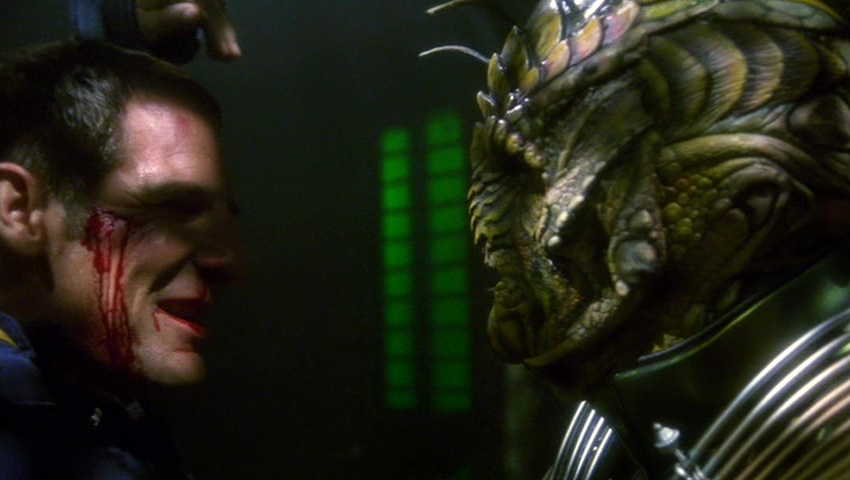
But let’s be honest: season three is about the action. It’s about stopping the Xindi at all costs. And I mean at all costs. And they do. And it’s amazing.
Remember when I said that I first discovered Enterprise in the very early episodes of the third season? Part of what hooked me so deeply to the show was indeed this intense season-long battle with the Xindi. It’s great television and super exciting, all of it. I couldn’t wait for those new episodes to air every week and with good reason. I highly, highly recommend Enterprise for this season.
Then season three ended. The super weapon was destroyed, the Xindi were defeated, Earth was saved, and the Enterprise crew were welcomed home as heroes.
And thus ends the goodness of Enterprise. Farewell, my favorite Star Trek show. Thank you, sincerely.
Enterprise Season Four: Just…why?
But what about the fourth and final season of Enterprise, I hear you ask. What happened and why was it so bad?
I’ll tell you what happened to make the last season so bad: the show was cancelled, that’s what happened.
In fact, I still remember it quite clearly. I was sitting there watching the massively epic, edge-of-your-seat thrilling season three finale when Captain Archer is fighting the Reptilian Xindi bad guy and blowing stuff up and all sorts of crazy stuff is going down.
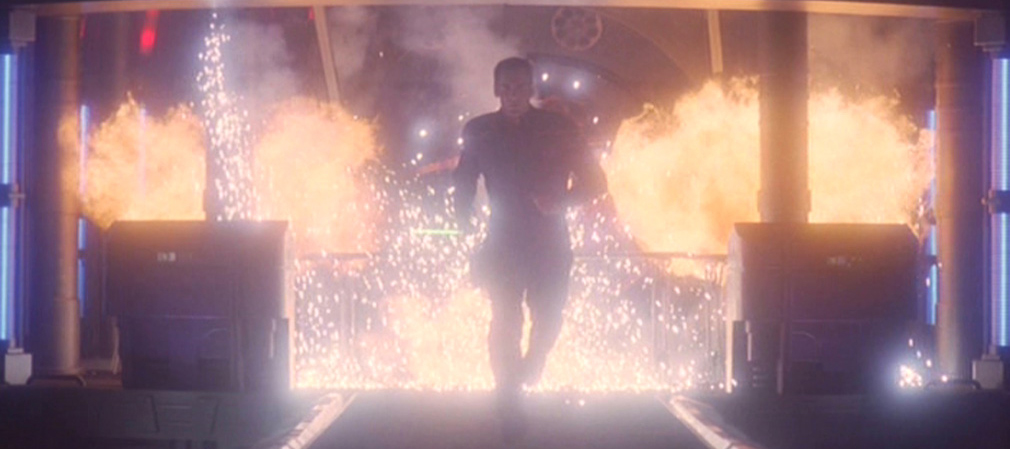
And then there was a commercial break. “Back in my day our shows stopped every now and then for a whole bunch of loud and annoying commercials. And there was nothing you could do about it!” I say in my little old lady voice.

And what sort of commercial did I see, in the midst of all the finale’s excitement? A commercial for Enterprise’s fourth season, actually, but the announcer voice said, good and loud, “Join us for Enterprise’s final season!”
Awhaat?
Let me tell you, that is super not what I wanted to hear in the middle of watching the awesome season finale of my favorite show. Talk about a killjoy!
But let’s talk for realsies about it.
Despite its awesome pilot episode, Enterprise sort of hobbled through its first two seasons, doing some good stuff here and there, but it struggled to find its footing and ratings were…fine.
Now, don’t fault Enterprise too much for this because it’s not alone in having a rough start in the Star Trek universe. Why The Next Generation was ever renewed after its first season truly baffles me. At least Enterprise had some great moments in its first season but the first season of Next Generation is just really, really bad.

Enterprise’s season three was awesome, but apparently not awesome enough. So it was only renewed for a fourth and final season, kind of out of pity, if you ask me.
And so season four, which I indeed watched faithfully, felt like a mad scramble to fit in all those prequel-type things, to tie up all those other storylines, and to shove it all in there super, super fast.
I actually really pity the creators and writers during this season of the show. I like to imagine that when they very first pitched the idea of Enterprise and all started brainstorming and planning all these cool things, everyone was so excited to make a prequel. “We can do this, this, and this all leading up to the creation of the Federation!” I can hear someone exclaim, giddy with excitement.
“Here’s a thought,” another adds. “What if this Captain Archer character helps start the Federation, and we get to see his story about how it all happens!”
“Ooh, yeah, that’d be so awesome!” they all respond, bubbling happily with ideas and suggestions.
And then, just a few years later, the show gets cancelled. Ouch. And I imagine this same group of creators and writers, no longer excited and bright-eyed, but frazzled and disappointed. “But we never got to do this, or this, or this. And what about creating the Federation? It was going to be so cool.”
“Well, let’s shove it in there!” the most harried and crazy-eyed one shouts. “Just shove it in! We have, what, twenty-plus episodes? So let’s shove in all the most important stuff. All the prequel stuff, all the cameo appearances, all the storylines! Go, go, go!”
And thus…season four.
On top of its rushed feel, season four also tried to use the on-going story style that made season three such a success. But they didn’t have a season-long story this time, just a ton of little two- and three-part episodes that somehow felt long and drawn out in such a rushed season. I really think they were just trying to capitalize on those cliffhangers and milk them for all they could.
For example, they had to wrap up the Temporal Cold War. How? With a two-parter where they travel back to World War Two, do a bunch of stuff, and then…boom. Temporal Cold War over and done, no more.
And move on!
What about T’Pol’s mind-meld disease? The fractured Vulcan culture? How can we resolve all that? With a three-parter where Archer goes to Vulcan and finds the original “Bible” with the true Vulcan-Jesus teachings that will take care of everything. T’Pol? Cured. Mind melds? Okay now. Vulcan culture? Set right.

And move on!
What about reconciling all those fighting species, especially all those issues between the Andorians and the Vulcans? Will they ever unite and form a Federation? After so many years of grudges and betrayals and mistrust? Will they, will they?
Yep, in a three-parter, of course! We’ll throw in some random threat and they’ll all come together to fight it.
But won’t it be hard, getting everyone to work together like that? No—we don’t have time for it to be hard. Just make the two-parter! Go! Go! Go!
And move on!
But wait! The writers really wanted to do a dark universe episode. Well, pump that sucker out in a two-parter! Nostalgia satisfied? Winks winked? Original series referenced? Coolio.
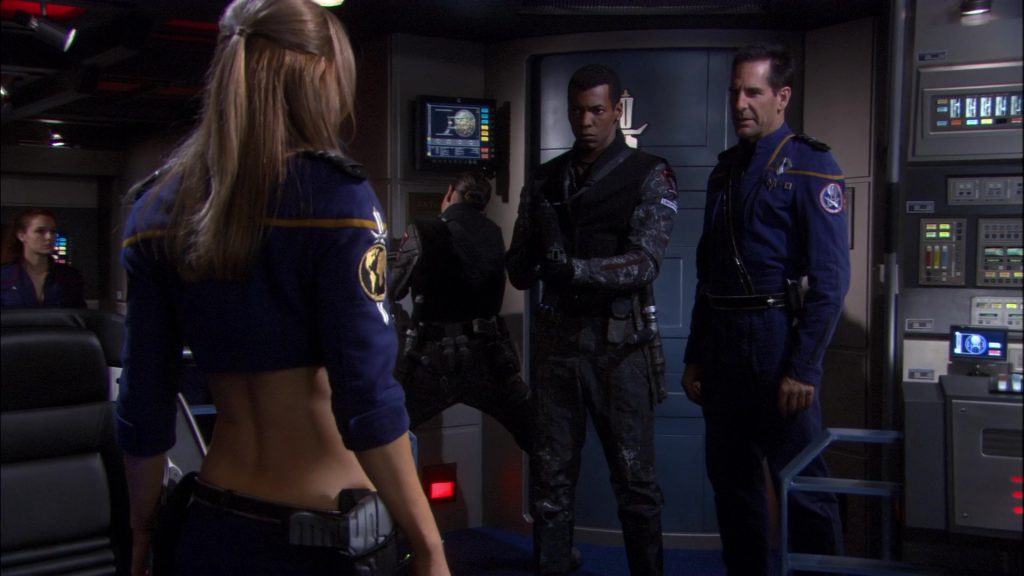
And move on!
“We were going to explain why the Klingons look different in the Original Series!” one writer whined. Pump that sucker out too. Another two-parter! Do it! Do it! Nostalgia satisfied? Winks winked? Original Series referenced? Coolio again.
And move on!
Another uber-necessary (not!) nod to the Original Series, we must reference Khan! How? With a two-parter, of course! Genetically engineered humans, “augments,” are causing chaos and running amok. They kill a bunch of Klingons and kill a bunch of doctors. And do they reference Khan? Oh heck yes they reference Khan. Do they do anything else that’s relevant to anything, ever? No, but oh heck yes do they reference Khan!
Oh yeah, and shove that Brent Spiner cameo into this two-parter. Beef that up for the commercials, over and over and over. This is the ancestor of Data’s creator! Wow! And in the last two seconds of the two-parter episode, he says a line about creating artificial intelligence…meaning Data the android! Gasp! Wowzers!
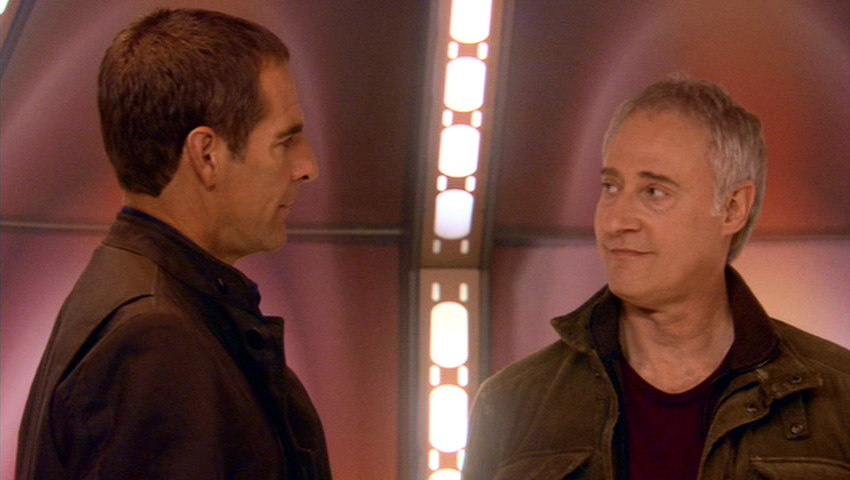
Did this have anything to do with the augments? No. Did this have anything to do with the Khan reference? No.
But hey, those rushed and frantic writers got two birds with one stone; they gave nostalgic winks to both the Original Series and to Next Generation at the same time. And Brent Spiner was in it! Coolio, coolio, coolio.
And move on!
Now I don’t want to harp on these poor episodes too harshly. They weren’t exactly bad, not by any means. Some of these were still exciting and intriguing television to watch. I particularly enjoyed the episodes about Archer and T’Pol on Vulcan and when Dr. Phlox is kidnapped by the Klingons to help cure a plague that eventually leads to the Klingons losing their forehead ridges. There’s even a reference to the mysterious Section 13, which is a cool little nugget to put in there.
But it wasn’t great. All of these were just…just fine. It’s fine.
Unfortunately, most of season four was poor prequel writing. Where the first two seasons made really good use of its prequel-ness, the final season absolutely did not. All of these winks and nods to other Star Treks felt forced and rushed; it simply existed for the sake of existing.
What about my beloved Enterprise crew? What about all that character growth? What about all those other guys?
They don’t matter, not as long as Brent Spiner is a guest star.

Except for Captain Jonathan Archer, of course. He makes all of this happen because this is, after all, The Captain Jonathan Archer Show (plus Brent Spiner)!
Now I can’t single out Enterprise as the only Star Trek show that lost sight of its other characters because Voyager was guilty of the same thing. By the end of its run so many episodes were entirely Seven-based that I jokingly called it The Seven of Nine Show, just like here with Enterprise. Oh yeah, Tom and B’elanna are a thing, and the Doctor is still a hologram, and…and…and…more Seven! More Seven! More Seven! But Seven was one of my favorite Voyager characters, so I guess that’s all fine.
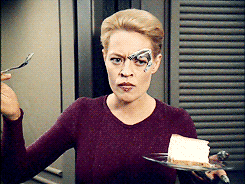
But Enterprise did very much the same thing. Hoshi’s big arc about overcoming her fear of space travel? Not a thing anymore. Bonding between any other characters? Nope. Is Phlox still funny? Not really. Does anyone else exist? I forget. Oh yeah, except the previously-mentioned Tucker and T’Pol. But they stopped all their sexy Vulcan yoga and then did…nothing. Literally nothing.
Actually, let’s pause here and talk about the relationship between Tucker and T’Pol.
It was in season three when Commander Tucker was medically prescribed this Vulcan yoga workout thing to help him cope with the trauma of losing his sister in a Xindi attack. And T’Pol is the one who guides him in this yoga thing, even though she is reluctant at first, claiming that the ritual is very “intimate.” That’s code for “sometimes we’re only mostly-clothed.”
And that sums up their relationship: whenever the writers felt like they needed to “sex-up” the script a bit, they threw in a few scenes of Tucker and T’Pol doing their medically-ordered sexy Vulcan yoga. This is still television, after all, and unfortunately sex sells.
So they tried to push this “relationship” between Tucker and T’Pol, but I never really liked it (I would have liked Travis and Hoshi so much more, but they’re not main enough main characters, I guess). Mostly my issue was that Tucker and T’Pol had very little chemistry, very little reason to actually be a couple…besides the sexy Vulcan yoga. Their relationship was too forced and never progressed to be anything more.
Like season four, their relationship wasn’t ever great, but it was just fine.
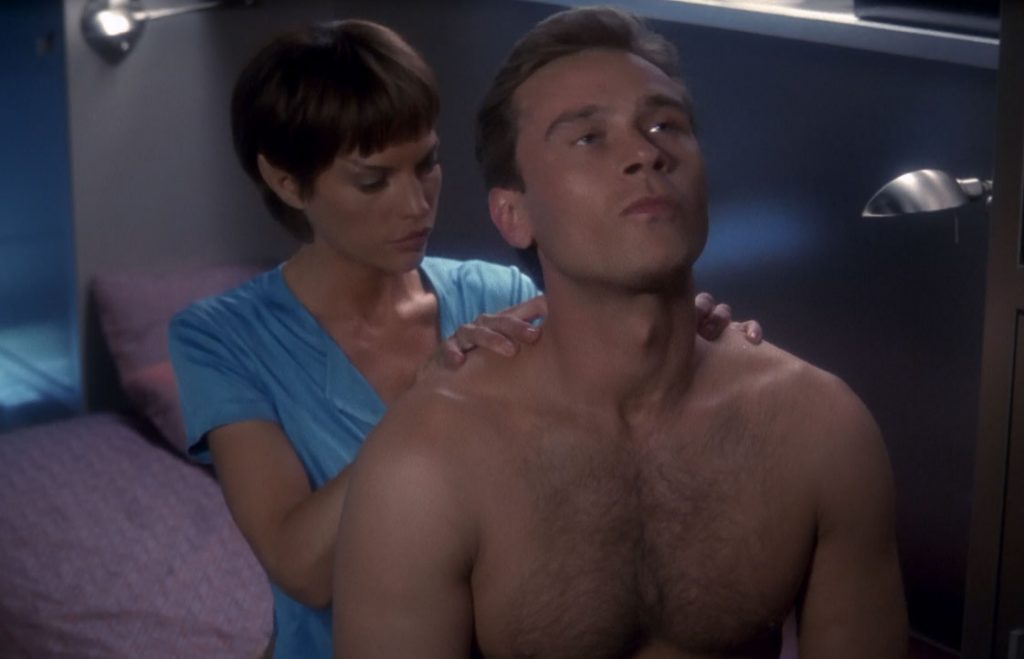
Remember above I cited T’Pol as being one of the most interesting and best-written characters of the show, and I stand by that. I will give her a little credit here: she indeed continues her previous story arcs and it all works quite well. This further development added another layer to her character in season three: she gets addicted to a certain drug that allows her to experiment with her emotions. It’s all actually pretty interesting, and a dark turn for T’Pol.
Except that it doesn’t really go anywhere: she isn’t really changed or affected by this arc like she is in her growing loyalty to Captain Archer…
…except that now she does sexy Vulcan yoga with Commander Tucker.
So ultimately, the sexy Vulcan yoga has a lot more to do with T’Pol than it does with Commander Tucker, as he becomes sort of her “outlet” for her emotions, for lack of a better term. Yes, it’s a bit odd, I know. But it’s what happens.
And then they stop doing their Vulcan yoga in the last season and do nothing else. Literally. They pine for each other a bit, but they don’t do anything. I just got bored with them, I guess. Like I said, their entire relationship was just fine.
Compare their relationship to Tom and B’elanna’s in Voyager. We get the pleasure of watching their entire relationship progress through dating, newlyweds, married life, and finally a first pregnancy. Their relationship has some solidity to it, some chemistry, some oomph. They argue, they have lovely moments, they have a lot of tension, and it’s great. Their relationship progresses with the characters; they are changed by their relationship, as couples should be, and they grow together.
Tucker and T’Pol, unfortunately, get none of that. Partly, I’m afraid, due to lack of time. Tom and B’elanna got years and years of on-air episodes to progress through their relationship; Tucker and T’Pol barely got two.
At the very end of season four in the two-part episodes, “Demons” and “Terra Prime” is when their relationship is mostly wrapped up…mostly.
In the episodes, a xenophobic terrorist bad guy from Earth is wreaking all sorts of havoc, convinced, after the Xindi conflict, that all other aliens are bad and humans need to be kept “pure” from them. His big bargaining chip? A half human/half Vulcan baby he cloned and grew from Tucker’s and T’Pol’s DNA.
Yes, you read that right: he cloned them a baby. This is after all, still Star Trek, remember.
Why was growing this test-tube baby necessary for his evil, xenophobic, terrorist plot? So Tucker and T’Pol could have a baby, of course. Why did he choose them, specifically, and their DNA, out of all the other humans and Vulcans in the galaxy? Because they did sexy Vulcan yoga in the previous season, of course, and the writers have to wrap that all up.
Where the heck did he get their DNA to clone and grow a baby? It’s vague. Just roll with it.
Despite those episodes’ weirdness, they were actually really good, by season four standards. They do indeed set up these very touching moments between Tucker and T’Pol bonding (for the first time, like actually bonding, like real relationship bonding) over their baby girl.
Ultimately and tragically the baby dies from shody clone-work, strengthening their bond even further and adding that big emotional punch so many other season four two-parters were missing. It’s quite touching and I really enjoyed it. Well done!
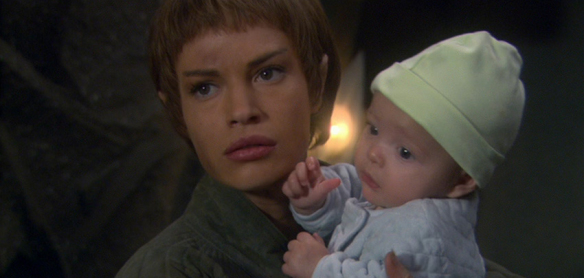
It’s sort of like a what-could-actually-be-between-us kind of feel for Tucker and T’Pol, like solid proof that they are indeed compatible and should indeed pursue an actual relationship (one that involves a little more realness than just sexy Vulcan yoga).
But that’s the very final episode before the series finale; there just wasn’t time to do anything further with Tucker and T’Pol, even if they wanted to, which is a downright shame.
But, after ending on that nice moment together, the series finale completely stomped out any and all of it. As the finale takes place in the future, Tucker and T’Pol’s relationship is mentioned as a past tense question. “Did they ever get together?”
“Nope.”
Oh. Okay then.
And that’s it.
Seriously, what the heck? There was such a huge build up of trying and forcing and pushing them to be a couple, even when it was just fine. The writers so wanted that sexy Vulcan yoga to pay off in some way, and I thought that they actually did a good job of showing that payoff in “Terra Prime.”
Nope. Never mind. All of that was meaningless and led nowhere. Nothing. Nada. End. Even though I wasn’t very emotionally invested in their relationship, it still ended in absolutely nothing.
Remember when I talked about lost potential? Season four had a lot of that.
Okay, Tucker-T’Pol rant done. Let’s return to discussing season four as a whole.
There is, indeed, a great nugget of goodness worth acknowledging in season four: episode three, “Home.”
When the crew finally returns after their epic battle with the Xindi as big heroes, they get some much-needed shore leave and relaxation after such an ordeal, all while their barely-hanging-on-by-a-thread ship finally gets repaired, of course.
But the poor captain, however, doesn’t have such a pleasant time. He has to face a difficult meeting with Star Fleet Command rehashing and defending all those morally hard decisions he had made in the previous season. And yeesh, it’s super harsh.
In the midst of all this, Captain Archer reconnects with an old girlfriend who is going to captain the second warp-5 starship (Enterprise’s sister ship) which is just about to launch.
They go rock climbing together, where Archer has a really emotional conversation with her. He tells her that he used to be just like her, wide-eyed and hopeful and excited to explore the galaxy. But she’s naïve, he says, just like he used to be. Now after his graphic and violent conflict with the Xindi and after all the morals he compromised throughout, he’s lost that sense of wonder and purpose and doesn’t know how to get it back.
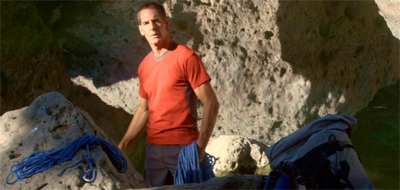
Mmm. Right in the feels!
What a powerful moment! It’s a really good episode and a great moment for Archer’s character.
It has kind of a similar feel to the Next Generation episode “Family” when Picard visits his home right after he’d been captured and assimilated by the Borg, and then he wrestles with his brother in the mud and has an emotional break down and yells about how horrible that experience was for him and how guilty he feels. Picard gets a much-needed kick in the pants, but still grapples with his guilt and grudge against the Borg for years to come.
Archer, on the other hand, doesn’t have the luxury of four following seasons to explore this darker side of his character and tackle his guilt. He never gets another chance to address any of this. Oh, how I would have loved some future episodes that revisited this theme where Archer gets a chance to rediscover his purpose and passion for exploration.
But those episodes never happened.
Instead, the dying show then shoves in as many two-parters as it can get. There’s no time for Archer’s character arc, not when Data’s creator is making genetically-augmented humans kill Klingons! Hurry, hurry, hurry!
Of course I can’t get by without mentioning the season and series finale, “These are the Voyages.” It’s just bad in every way, absolutely infuriatingly bad. It was like a spit in the face to such a devoted fan who loved and followed these characters and then had her favorite show cut short.
Just for your own benefit, reader, I’ll sum up the episode so you can fully appreciate how…unfortunate it was. The episode actually features the drastically important cameo appearances of Counselor Troi and Commander Riker from The Next Generation, who are revisiting this two-hundred-year-old Enterprise in their holodeck.
Yep. It means my beloved Enterprise crew aren’t even the main characters in this episode, their finale episode: Troi and Riker are.

The Enterprise-based story that Troi and Riker are watching takes place six years after the previous episode, “Terra Prime.”
And what has Enterprise and it’s crew been doing in those six years? Nothing we know of (quite literally in the case of Tucker and T’Pol).
This is the story of Captain Archer preparing to make his historic speech that starts the Federation. Like, this is the big beginning of it all, and I assume what the writers wanted in the first place. In theory it’s a great idea, having Archer help create the Federation, but they just didn’t have time to make it happen, so they just jumped forward in time and shoehorned it in anyway. So now it feels awkward and meaningless, a payoff that no one earned.
But Troi and Riker are in it, so…
Actually I don’t care that they are in it. The episode is just plain bad and I feel like I’m being stabbed in the back for the whole thing.
I hate to end this analysis of Enterprise on a bad note, but I guess it’s appropriate because the show itself also ended on a bad note. And that makes me sad.
But back up a little bit and remember the most important takeaway here: Enterprise has a lot of great things going for it, especially in those first three seasons. Don’t write off this Star Trek underdog just because the last season wasn’t very good.
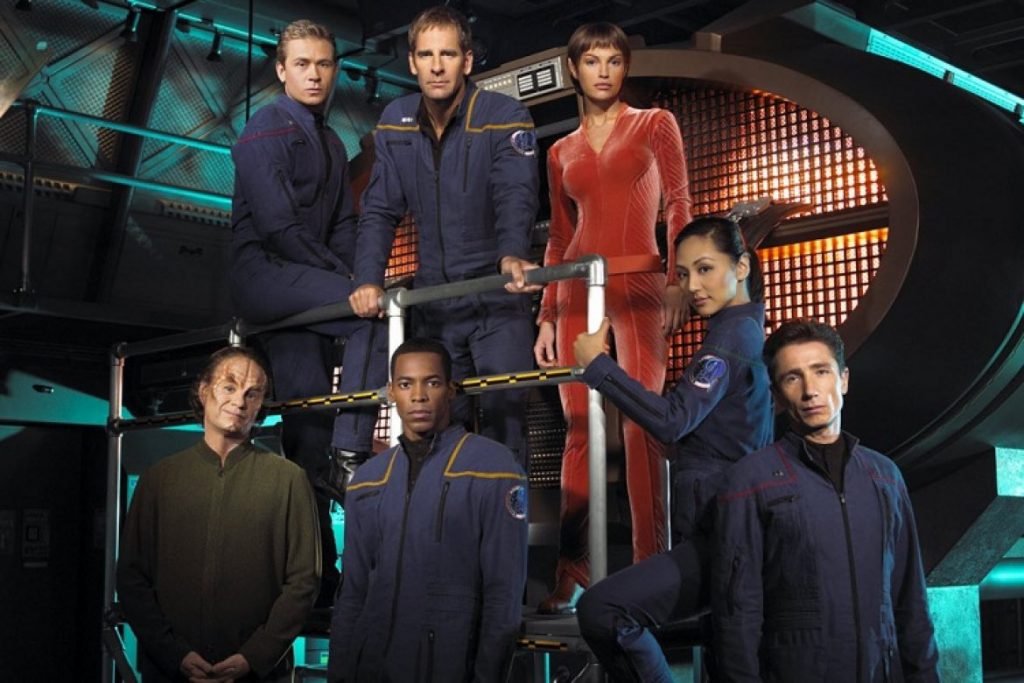
Basically Enterprise is great and I still cherish it as my favorite Star Trek show.

